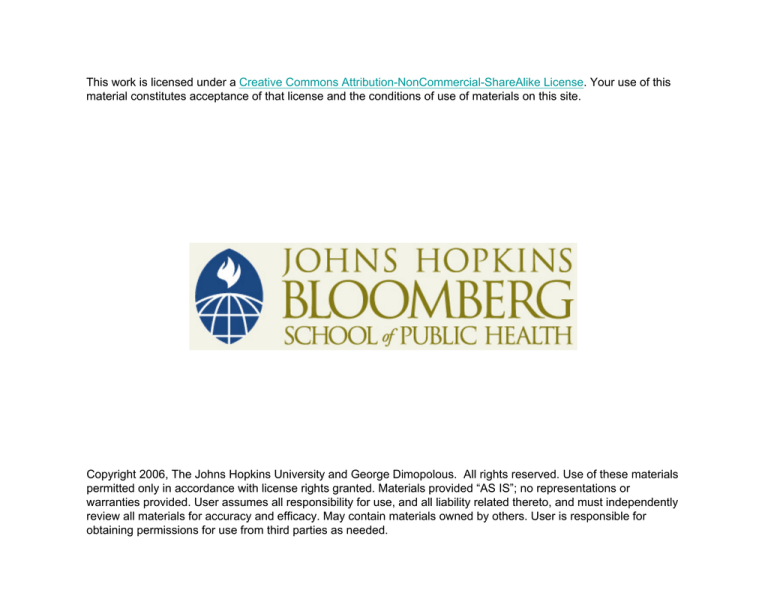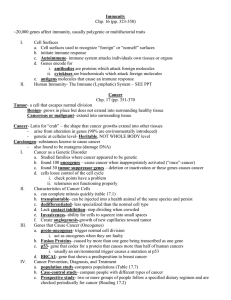
This work is licensed under a Creative Commons Attribution-NonCommercial-ShareAlike License. Your use of this
material constitutes acceptance of that license and the conditions of use of materials on this site.
Copyright 2006, The Johns Hopkins University and George Dimopolous. All rights reserved. Use of these materials
permitted only in accordance with license rights granted. Materials provided “AS IS”; no representations or
warranties provided. User assumes all responsibility for use, and all liability related thereto, and must independently
review all materials for accuracy and efficacy. May contain materials owned by others. User is responsible for
obtaining permissions for use from third parties as needed.
Genomic Analyses of
Anopheles-Plasmodium Interactions
George Dimopolous, PhD
Disease Control
VECTOR
PLASMODIUM
HOST
ERADICATING MALARIA
Mosquito: A Model For Innate Immunity
Filaria
Plasmodium
Fungi
Viruses
Bacteria
pathogen Innate Immune System
PATTERN RECOGNIOTION RECEPTORS
SIGNAL AMPLIFICATION
PATHWAYS
SIGNAL
TRANSDUCTION
PATHWAYS
(Toll, IMD)
EFFECTOR GENES
PHAGOCYTOSIS
MELANIZATION
Strategies For Malaria Control
insecticides, repellents, bednets,
genetic control
Kill, or avoid contact with the vector mosquito
human
Kill the
parasite in
mosquito
Drugs
Vaccines
Transmission blocking vaccines
Genetic modification of mosquito
EFFECTOR GENES
Toxins
Kill the parasite
Mosquito immune system
Interfere with parasite – mosquito interactions
PROMOTERS
(tissue & stage specific)
GENETIC DRIVE SYSTEMS
(i.e. transposable elements, endosymbionts)
Anopheles Immune Defense Against
Plasmodium Infection
Midgut invasion
Traversal of peritrophic
matrix; parasite chitinase
is activated by mosquito
trypsin
Blood meal
Peritrophic matrix
Ectoperitrophic space
Attachment to microvilli
carbohydrate.
Recognition of specific
cell type
Midgut epithelium
Invasion & traversal
Basal laminae
Hemocoel
Shahabuddin
Trigger for oocyst
development
Anopheles Immune Defense Against
Plasmodium Infection
How do be assay the biological processes?
Control of physiological processes
transcription
transcript
translation
protein
Transcription Analyses of Immune
Responses to Plasmodium
naïve blood
Plasmodium infected blood
Quantitative RT-PCR of
immune marker genes
Adapted from Dimopoulos et al., EMBO J 1998;17:6115-6123.
Anopheles Gambiae Gene Discovery
Project (Year 2000)
cell lines
Normalized cDNA libraries
Sequencing 3840 random clones
~6200 ESTs
sequence
analysis
2287
1118
858
28
48
unique genes
genes with database hits
genes with assigned function
previously cloned A.g. genes
putative immunity genes
Adapted from Dimopoulos et al. Proc Natl Acad Sci USA 2000;97:6619-6624
2001: A. gambiae Cell Line EST 4000 Array
~2200 unique genes
~858 genes with assigned function
4a NF vs 2.33 18h
Dimopoulos et al., (2002) Proc Natl Acad Sci U S A. 99(13):8814-9.
Clustering of Cell Line and Mosquito
Responses
Injury
Plasmodium
Sterile Septic infection
CELL LINE
genes
Genes that are implicated in
anti-Plasmodium defense.
Dimopoulos et al., (2002) Proc Natl Acad Sci U S A. 99(13):8814-9.
up-regulated
not regulated
down-regulated
experiments
A. gambiae Genome Sequenced
and Annotated in 2002
Size: ~260 mega bases
~13.000 predicted Anopheles
proteins
GAMBER 22K: Anopheles gambiae – Plasmodium berghei microarray
P. berghei: ~5,6K genes
P.y.
582
P.f. ortho.
3,893
P.c.
1,176
Collab .: N. Hall, TIGR
A. gambiae: ~ 13K genes
3’ exon biased
exon specific oligos for 300 genes
Collab.: E. Monguin, Harvard
From Dong Y, et al. PLoS Pathog 2006;2(6):e52
2004: Complete transcriptome
Gene Expression Profiling Can Assess and
Identify:
Host (Human mouse, rat, etc..)
•Immune & other physiological responses to infection
•Resistance & susceptibility genes
Vector (Mosquito, Sandfly, Tsetse, etc…)
•Immune and other physiological responses to infection
•Resistance (refractoriness) & susceptibility genes
•Effector genes
•Tissue specific promoters
•Fitness signatures
•Insecticide resistance factors
Pathogen (Plasmodium, Leishmania, viruses, bacteria, etc)
•Virulence factors
•Infection stage specific markers
•Drug and vaccine target genes
•Other disease control target genes
Functional Compartmentalization of the
Midgut
cardia
anterior
-Cardia
secretion of type II Pm
expression of defensin
secretory cells
anteriorposterior
posterior
- Anterior midgut
- Posterior midgut
sugar absorption region
no enzymatic activity
no change in morphology
cells with less microvilli
synthesis/secretion of proteolytic enzymes
absorption of blood digestion products
distension (25um 2.5um high)
stretching of basal lamina
different cell types
Plasmodium Infection of the Midgut
Transcriptomic Dissection of the Midgut
Transcriptomic Dissection of the Midgut
Transcriptomic Dissection of the Midgut
Transcriptomic Dissection of the Midgut
Responses to Plasmodium Invasion of the Midgut
Responses to Plasmodium Invasion of the Midgut
Responses to Plasmodium Invasion of the Midgut
Responses to Plasmodium Invasion of the Midgut
Responses to Plasmodium Invasion of the Midgut
Responses to Plasmodium Invasion of the Midgut
From Dong Y, et al. PLoS Pathog 2006;2(6):e52
Responses to Plasmodium Invasion of the Midgut
• Conclusions
– P. berghei ookinete invasion results in a broader
response, comprising more genes. A likely result of the
higher infection level.
– Invasion by P. falciparum induces a larger number of
immune genes, that are qualitatively different.
– Malaria infected blood triggers a broader physiological
response including immune responses. Are these
important for anti-Plasmodium defense?
Reverse Genetic Analyses of
Anti-Plasmodium Function
From Dong Y, et al. PLoS Pathog 2006;2(6):e52
Reverse Genetic Analyses of
Anti-Plasmodium Function
From Dong Y, et al. PLoS Pathog 2006;2(6):e52
Reverse Genetic Analyses of
Anti-Plasmodium Function
From Dong Y, et al. PLoS Pathog 2006;2(6):e52
Immune Defense Against Plasmodium in the
Midgut
• Conclusions
– Anopheles anti-Plasmodium defense is
mostly universal, with some parasite species
specific activities/ mechanisms.
– Anopheles is using components of its
antimicrobial defense system to combat
Plasmodium.
Anopheles - Plasmodium Interactions
• Don’t forget the Pathogen
• Parallel transcription analysis of
Anopheles and Plasmodium can identify
expression signatures of interacting
processes.
• See: Xu et al. 2005 Molecular &
Biochemical Parasitology
Proteome Analyses of Insect Immune Responses
transcript
protein
function
low resolution
Engstrom (2004) Trends in Biotechnology Vol.22 No.11






